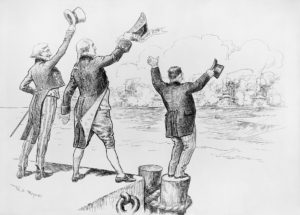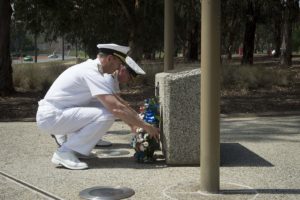Why Naval History Matters
First, we should establish what, in fact, is history. Is it the recitation of strings of dates, glorious military and naval victories, lists of kings and queens: or is it, as has been said, simply ‘one f…..g thing after another’?[1] E H Carr asked the question ‘What is history?’ He defined it as ‘an unending dialogue between the present and the past’ and added that the role of the historian is to ‘… master and understand [the past] as a key to understanding the present’ by a continuous interrogation of the sources, and constantly asking ‘Why?’[2] History, thus, is not static. It is capable of re-interpretation in the light of new discoveries or varying perceptions of the material.
The British have been recording the battles and voyages of the King’s ships and their commanders since the time of the Vikings, with Southey’s Life of Nelson becoming a best-seller within six years of Trafalgar. Other Nelson authors adopted a style which was essentially hagiographic, while supporting the interests of either Lady Nelson or Emma Hamilton. Referring to his life of Vice Admiral Sir Jahleel Brenton, the Rev. Henry Raikes (founder of the Sunday Schools movement) said: ‘My desire … was to do good to others, rather than to do justice to my subject.’[3] Commencing in 1897. W L Clowes compiled a seven volume history of the Royal Navy ‘from the Earliest Times to the Present’,[4] which became the standard reference at that time with contributions from A T Mahan and Theodore Roosevelt for an American perspective. Mahan was writing, at that time, encouraging ‘navalism’ in the USA, while Roosevelt, as president, dispatched the ‘Great White Fleet’ on its round the world, flag-showing voyage. The incursion of that fleet into what had previously been seen as British waters contributed to a push for an Australian navy.

“Welcome home!” Political cartoon with Uncle Sam, George Washington, and Theodore Roosevelt celebrating the return of the Great White Fleet to its home port at Hampton Roads, Virginia after a two year world tour . (Credit: Wikimedia Commons).
The Society for Nautical Research (1910) was founded ‘to encourage research into matters related to seafaring and ship building in all ages among all nations’[5] and the Navy Records Society (1893) was formed for the purpose of publishing original materials on the history of the Royal Navy’,[6] both largely under the auspices of John Knox Laughton, L.G. Carr Laughton, Julian Corbett and Geoffrey Callender. Many of the original contributors to the publication of these two bodies were, as Lambert describes ‘constructing’ naval history, through the analysis of tactics and the application of sea power for the education of serving officers, and policy, politics and diplomacy.[7] It was perceived that ‘[t]he raw material of the naval staff officer is the naval historian’s finished product.’[8]
Popular culture also embraced the Royal Navy and its ‘tars’. Fred Jane wrote of ‘The British Battle Fleet’ and other naval topics as well as publishing the annual ‘Fighting Ships’ identification manual. In Australia, Ernest Protheroe described ‘The British Navy – Its Making and Its Meaning’ dedicated to all the sons of the Empire. Gilbert and Sullivan, and the music hall, told of the navy: ‘whose praise Great Britain loudly chants.’[9] During the 1950s, Melbourne celebrated Trafalgar Day with marching bands, field-gun races, mock naval battles, and visits from fleet units to Port Melbourne. It has been suggested that references to Nelson should be removed from the study of maritime history as representative of the ‘idolatry and dysfunctional worship of Britain at the time of its empire’ as typified by crowd behavior during the finale of the Prom concerts.[10]
There had been a tension between the role of naval history and that of maritime history in the collection policies of the National Maritime Museum; however, Knight identifies a ‘new’ naval history that emerged from the 1950s and which ‘assesses naval strength and weakness in terms of politics, economics, administration, materiel and manpower, state credit and technological development as well [as]… prize money and privateering.’ [11] Naval history is seen as not only part of maritime history but also of national history as expressed by Rodger in the introduction to the first volume of his Naval History of Britain: ‘It is interested in all connections between national and naval history, and seeks to make each known to the other’.[12] ‘The fighting instrument… may be seen as the product of the policy which employs it, the wealth which supports it and the organization which supplies it. None of these factors is independent of the others.’[13]
Facilitating the continuing and developing study of the naval history slice of the National history ‘cake’[14] has been the opening up and availability of extensive primary source material within the National Archives, coupled with the use of powerful electronic tools to sift that material. Readily available are published guides to the naval records in the National Archives, National Maritime Museum and the National Museum of the Royal Navy. Although history has been a powerful tool to motivate those serving and foster national pride, Hattendorf warns that this is ‘an approach that can be, and has been, misused by totalitarian regimes.’[15] An ethical academic approach adopting ‘… critical analysis of documents, factual accuracy, and commitment to the truth of what actually happened’[16] is required; echoing Carr’s insistence on the interrogation of sources and the continuing application of the question – ‘Why?’
Naval history can, and does, develop the facility to understand the development of strategy and its implementation, however, knowledge of past events is ‘one of several means to improve the ability of professionals to solve problems more wisely than arbitrary choice, pure chance, or blind intuition would allow.’[17] Public interest in naval history continues, and is maintained by popular narrative books and articles (both non-fiction and fiction), television documentaries and films, open days on visiting ships and public ceremonial and memorial parades.

CANBERRA, Australia (Feb. 10, 2015) ) Adm. Jonathan Greenert and Vice Adm. Tim Barrett, the Australian chief of navy, lay wreaths at the Royal Australian Navy Memorial on Anzac Parade, in honor of the men and women of Australia’s sea service. (Credit: U.S. Navy photo by Chief Mass Communication Specialist Peter D. Lawlor/Released)
It is imperative on the academic historian to provide ‘independent thinking and scholarship …to create the fundamental historical understanding of maritime and naval events that serves as the basis for … all the other audiences.’[18] Naval history has been likened to a thick forest – so thick that attempting to limit its boundaries, restrict its scope or define what it is, or is not, becomes immediately debatable. ‘Such is one of the genuine delights of the subject for the researcher and the enthusiast.’[19]
Naval history has, thus, been used to train serving naval officers in strategy, to develop policy, to justify political decisions, to feed jingoism and national pride and to educate the public on the role of the navy. It will continue to stimulate academic enthusiasm and interest as long as historians approach the particularly naval slice of the national historic ‘cake’ with that most penetrating of questions: ‘Why?’
[1]Alan Bennett, The History Boys play/screenplay, 2004.
[2] E H Carr, What is History, Penguin Books, London, 2008, 26; 30.
[3] C I Hamilton, ‘Naval Hagiography and the Victorian Hero’, The Historical Journal. Vol. 23 No. 2 (Jun., 1980) 384.
[4] W L Clowes, ed. The Royal Navy: A History from the Earliest Times to the Present 7 vols, S Low, London 1901.
[5] Society for Nautical Research website – accessed 21 October 2017.
[6] Navy Records Society website – accessed 21 October 2017.
[7] A D Lambert, ‘The Construction of Naval History 1815-1914’, Mariner’s Mirror, 97:1, 207-224, 2011.
[8] L G Carr Laughton, ‘The Writing of Naval history’ Mariner’s Mirror, 10:1, 30.
[9] W S Gilbert, ‘When I was a lad’, HMS Pinafore.
[10] Mike Bender, ‘Floating about Fleetwood: Should We Ban the N-word?’ in Floating About Maritime History, Bee’s Wing Publications, Kingsbridge, Devon, 2017, 9-14.
[11] Knight, Roger, ‘Changing the Agenda: the ‘new’ naval history of the British sailing navy’ The Mariner’s Mirror, 97:1, 228.
[12] N A M Rodger, ‘The Safeguard of the Sea – A Naval History of Britain 660-1649’, Norton, New York, 1997, xxv.
[13] J Ehrman J, ‘The Navy in the War of Willian III 1689-1697: Its state and directio’n, Cambridge, 1953 xv, xxii. Quotedby Knight, Roger, Changing the Agenda: the ‘new ‘naval history of the British sailing navy’ The Mariner’s Mirror, 97:1, 233.
[14] Ibid.
[15] John B Hattendorf,. ‘ The uses of Maritime History In and For the Navy’, Navy War College Review; Spring 2003; 56,2 , 25.
[16] Ibid, 25.
[17] Ibid, 34.
[18] Ibid, 29.
[19] Richard Harding, Modern Naval History: Debates and Prospects, Bloomsbury Academic, London, 2016.










Comments are closed.